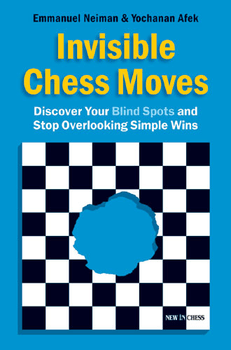| Nivå | B-D |
| Utgivelsesdato | Juli 2011 |
| Forfatter | |
| Pris | 220 NOK |
Invisible Chess Moves
Discover Your Blind SpotsEt imponerende materiale med stillinger der også kjente stormestere er "sjakkblinde", med trekk som enten den ene eller begge har oversett, av geometriske og psykologiske årsaker.
Vi mottok boka under Landsturneringen i Oslo i 2015 og bladde tilfeldig opp stillingen på side 109, der hvit - Salo Flohr i 1933 - ga opp, men hadde en mulighet, som heller ikke dagens gode norske spillere klarte å finne. Enkelt? Ja, etterpå.
Og forfatterne av denne boka klarer å sette "usynligheten" i system, slik at vi ha bedre håp om å kunne gjøre noe med den! Det er også mange teststillinger der vi kan vise om vi allerede er på bedringens vei...
Hovedpunktene i innholdsfortegnelse
- Part I: Objective Invisibility
.: Hard-to-see-moves
- Geometrically invisible moves
- Part II: Subjective Invisibility
- Invisible moves for positional reasons
- Invisible moves for psychological reasons
Introduction
While the strength of top chess play ers has grown significantly, they still often miss apparently simple moves. How can it be that players who are capable of calculating ten moves ahead for hours on end, fail to see a one-move win? More remarkably, in many cases both players make these over sights. Of course, it is al ways possi ble for a high-level player to make an elementary mistake. But normally speaking the probability of double blindness should be very slight.
Now a days (in 2011), players calculate like machines, since they are used to work ing with powerful computer programs. Most of them work di rectly on a com puter, thinking up their moves on a vir tual board while keep ing a small part of the screen open for a strong program that calculates and evaluates the po si tions. When a move that is natural for the human analyst is not taken into account by the computer, in most cases the reason will be that some tac tic has escaped the attention of the human player. Before checking this with the computer, any ambitious player will check the line for himself. Most of the time he will find the hidden trick and thus make significant prog ress in tactics. So, a player who keeps training in the oldfash ioned way, with a real board, nice wooden pieces, and just books and bulletins, will be confronted with tactically nearly invincible opponents and will have to adapt to a playing level that is considerably stron ger than it was in the 1980s, be fore the age of the com puter.
The present book deals with po si tions where a sim ple move is missed – often by both players. Our hypothesis is as follows: in chess, certain moves are harder to spot for a human be ing than other moves. For a beginning human player, clearly knight moves are more difficult to envisage than rook moves. With the rook, for ward moves are easier and more natural than back ward ones, and horizontal moves are frequently missed. The chess geometry and the han dling of each specific chess piece are difficult for the beginner, but they are no se cret for the experienced player. Nev er the less, even grand masters miss a back ward rook move more of ten than a for ward move, and for them, too, hor i zon tal moves are harder to find than vertical moves (see Chapter 2, ‘Geometrical in visibility’).
Also, a lot of el e ments in the games of ex pe ri enced players are me chan i - cal. In the open ing: de velop quickly and cas tle. In the middlegame: be care - ful with un pro tected pieces. In the end game: cen tral ize the king. The qual ity of a player can be es tab lished by the num ber of such in te grated principles that he knows. The stronger the player, the better he will be able to break such au to matical rules if that is nec es sary. Pro fes sional play ers are al ways ready to take ex cep tions and par a dox i cal moves into account. Even so, in this book we will see many examples of missed opportunities, where such ‘illogical’ moves are not taken into account (Chapter 3, ‘Technical in visibility’).
An other difficulty lies in the psychological aspect of the contest. Some - times a player may fo cus on the probable result of the game. According to his state of mind, he will expect to win, draw, or even lose, for ex am ple against a su pe rior opponent. In such situations, moves that ques tion the ‘nor mal’ re sult will be overlooked, even when they are elementary; they are ‘re pressed’, like in Freudian the o ries about the unconscious. Here technical factors are over pow ered by psychological factors. They may de pend on the evolution of the actual game, earlier con fron ta tions be tween the two pro - tag o nists, their status, titles, ratings etc. Such psychological cases of blind - ness are frequently reinforced by technical or geometrical difficulties; then a hard-to-find move will be come an invisible one due to certain stressful circum stances (Chapter 4, ‘Psychological invisibility’).
Obviously, other objective factors can ex plain mistakes, such as, es pe - cially, a lack of time to think. That is why we gen er ally try to avoid show ing mis takes from rapid, simultaneous and blind fold games as well as Zeitnot mis takes. We want to focus on games where both opponents had enough time to make a responsible decision.
The present book is organized as a trea tise, but for each di a gram the question is the same: What is the best move for White/Black?, and we can as sume that prob a bly the player was not able to find it in the ac tual game. For a good un der stand ing of our theme, it is nec es sary to look for the right move for a cer tain amount of time – the same amount you would use in or - der to make a de ci sion dur ing a normal game. So be fore look ing for the so - lu tion, try and discover the right move that Kasparov, Kar pov, Kramnik, Anand, Topalov or Carlsen was n’t able to find. Only then will you be able to fig ure out how ‘obvious’ it was.
| Innbundet? | Nei |
| Type | Bok |
| Språk | Engelsk |
| Antall sider | 240 |

